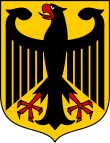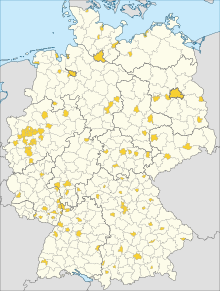- Districts of Germany
-
- This article is about the "Districts" (Kreise) of Germany. For the "Government Districts" (Regierungsbezirke), see Regierungsbezirk.
Germany 
This article is part of the series:
Politics and government of
GermanyConstitutionExecutiveLegislatureJudiciaryDivisions- States (Länder)
- Administrative regions
(Regierungsbezirke) - Districts (Kreise)
- Collective municipalities
- Municipalities (Gemeinden)
ElectionsForeign policy
The districts of Germany are known as German: Landkreise, except in the states of North Rhine-Westphalia and Schleswig-Holstein where they are known simply as German: ''Kreise'' (singulars: Landkreis and Kreis).
The districts are at an intermediate level of administration between the Länder (German states) and the counties or the municipal governments (Gemeinden). They are not to be confused with the larger Regierungsbezirk. They correspond to level 3 administrative units of the Nomenclature of Territorial Units for Statistics (NUTS 3).
The title German: "Reichskreis" (Imperial Circle) was given to groups of states in the Holy Roman Empire.
Contents
Types of districts
The majority of the districts are rural districts[1] (Landkreise) of which there are 295. Cities with more than 100,000 inhabitants (and smaller towns in some states) do usually not belong to a district, but take over district responsibilities themselves, similar to the concept of independent cities. These are known as urban districts (Kreisfreie Städte / Stadtkreise)—cities which constitute a district in their own right—and there are currently (2011) 107 of them, bringing the total number of districts to 402.
In North Rhine-Westphalia, there are some cities with more than 100,000 inhabitants which are not urban districts, for example Recklinghausen, Siegen, Paderborn, Bergisch Gladbach, Neuss and Moers. These cities, however, take over many district responsibilities themselves although belonging to a district. Moers is the biggest city in Germany (and at present time the only one with more than 100,000 inhabitants) that is neither an urban district, nor takes over district responsibilities.
There are also three so-called Kommunalverbände besonderer Art, a fusion of a district and a district-free town: Besides the Regionalverband Saarbrücken (1974–2007: Stadtverband Saarbrücken), there is the Region Hannover since 2001 and the Städteregion Aachen since 2009.
Responsibilities
The districts are responsible for the following:
- According to federal and regional laws:
- The building and upkeep of B roads
- Other building plans which cover more than one local authority's area
- Caring for national parks
- Social welfare
- Youth welfare
- The building and upkeep of hospitals
- The building and upkeep of state schools of secondary education
- Household waste collection and disposal
- Car registration
- Electing the Landrat or Landrätin, the chairperson of the district
- According to local laws: (differ in each region)
- Financial support for culture
- The building of pedestrian zones and bicycle lanes
- Financial support for school exchanges
- The building and upkeep of public libraries
- Revitalisation of the economy
- Encouraging tourism
- The management of Volkshochschulen (state run adult education colleges)
All these tasks are carried out by local (municipal) authorities operating together. Urban districts have these responsibilities and also those of the municipalities.
District council
The district council, the Kreistag, is the legislative body of the district and is responsible for local self-administration. The parliament is elected directly every five years, except in Bavaria where it is elected every six years.
District administration
The executive authority is an officer known as Landrat or Landrätin, who administers the district. In parts of northern Germany, this is also the name of the district administration, which in southern Germany is known as Kreisverwaltung.
District Court
The district court, or "Landgericht," is the court that has original jurisdiction in felony criminal cases where the time of imprisonment exceeds 4 years and certain other crimes, and appellate jurisdiction in all other cases. Decisions of the district court can be appealed to the Landesgericht or Oberlandesgericht (state supreme court), depending on the term used in each of the various states.[2] This is similar to judicial proceedings in some US states like Nebraska where all felonies are tried in district courts and misdemeanors originate one level below in county courts.
Lists of districts
- List of districts of Germany
- List of rural districts of Germany
- Urban districts of Germany
See also
Notes
- ^ Translation of terms: European Commission’s Directorate-General for Translation (DGT), Annex 5
- ^ German Rules of Court Act, Section 24 and Section 74
Articles on third-level administrative divisions of countries Albania · Algeria · Angola · Argentina · Belgium · Benin · Bhutan · Burkina Faso · Burma · Burundi · Cambodia · Cameroon · Chad · Chile · China · Costa Rica · Côte d'Ivoire · Democratic Republic of the Congo · East Timor · England · Ecuador · Estonia · Ethiopia · Finland · France · Germany · Guinea · Greece · Haiti · India · Indonesia · Italy · Japan · Kenya · Liberia · Lebanon · Lesotho · Lithuania · Luxembourg · Mali · Mozambique · Nepal · Northern Ireland · Niger · Panama · Papua New Guinea · Peru · Philippines · Portugal · Scotland · Senegal · Sierra Leone · Slovakia · South Africa · Spain · Sri Lanka · Switzerland · Tajikistan · Thailand · Ukraine · United States · Vietnam · Wales · Zimbabwe
Table of administrative divisions by countryCategories:- Districts of Germany
- Subdivisions of Germany
- Lists of country subdivisions
- Country subdivisions of Europe
- Third-level administrative country subdivisions
- Germany-related lists
Wikimedia Foundation. 2010.

